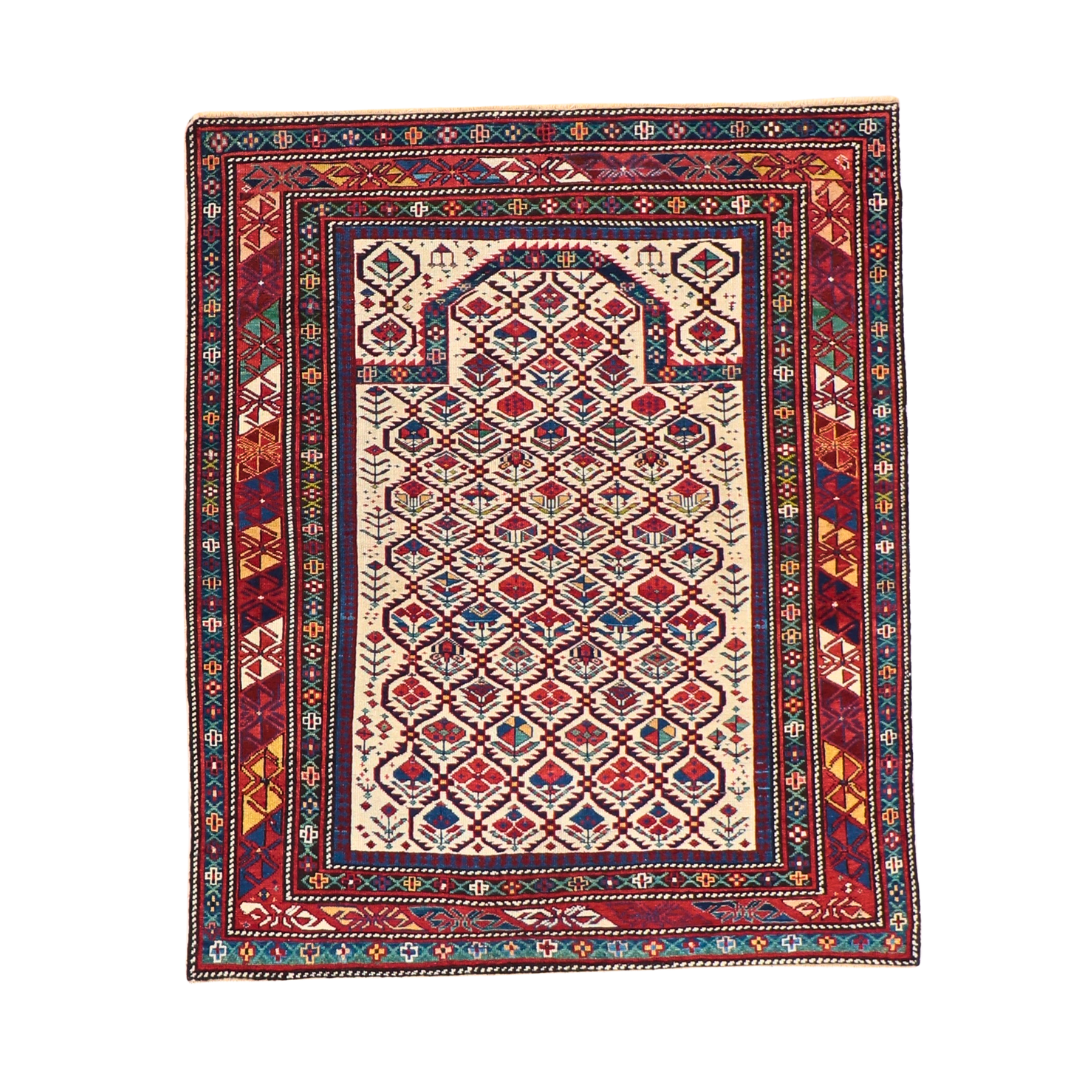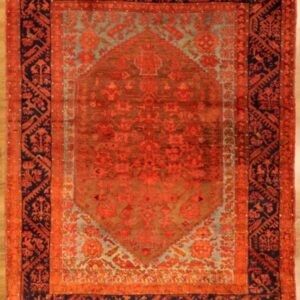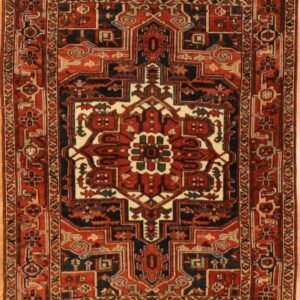Serial No.: 0009756
Origin: Marasali, Shirvan, Caucasian
Age: Late 19th century
Style: Tribal
Size: 3′ 5” X 4′ 2”
Material: Wool Foundation, Wool Pile, Vegetable Dyes
Color Scheme: Ivory, Red, Green, Yellow, Navy, Black
Provenance and Historical Context
This late 19th-century Marasali rug from the Shirvan region in the Caucasus exemplifies the refined tribal aesthetics for which the area is known. Marasali, situated in the broader Shirvan district, has historically produced rugs of remarkable intricacy and tight knotting, often distinguished by vibrant palettes and geometric-laden designs. Woven at a time when Caucasian weavers were blending longstanding village traditions with evolving market demands, this rug encapsulates both cultural authenticity and artisanal finesse.
Center Field in Ivory
A defining feature of this small piece, measuring 3’5″ x 4’2″, is its deep ivory center field. The field itself is populated by a scattering of stylized motifs—potentially latch-hook elements, small rosettes, or abstracted floral forms—that lend a sense of movement and depth. These motifs are rendered in blue, red, green, yellow, and black, creating a lively interplay against the rich subtle background. The ivory ground not only enhances the vibrancy of the secondary colors but also anchors the composition, establishing a strong focal plane typical of Shirvan rugs, where color contrast is both decorative and symbolic.
Intricate Border Details
Surrounding this central tableau are multiple borders, each featuring a unique series of repeating geometric or floral-inspired patterns. In Marasali weavings, it is common to see narrow guard borders flanking a main border, which might showcase stylized vines, star motifs, or abstract shapes referencing local folklore. These borders serve a dual purpose: they unify the rug’s overall design and protect the field from wear. The use of reciprocal motifs in the guard stripes further underscores the balance between negative space and pattern density, a hallmark of tribal Caucasian rugs.
Technical Weaving and Natural Dyes
Constructed with a wool foundation and wool pile, this rug is hand-knotted using symmetrical (Turkish) knots. This technique allows for clear, well-defined motifs despite the rug’s modest dimensions. Marasali rugs are known for their relatively fine knotting within the Shirvan tradition, reflecting the weavers’ meticulous approach. The colors stem from vegetable-based dyes, an eco-conscious practice that yields warm, natural tones. Madder root typically imparts the reds, local plant extracts offer the yellows and greens, while indigo or other mineral-derived dyes produce the deep blues and blacks. These naturally dyed fibers develop subtle tonal variations (abrash) over time, enhancing the rug’s sense of authenticity and historical resonance.
Era Hints and Areas of Use
During the late 19th century, tribal weavers in Shirvan continued to adhere to ancestral design philosophies, even as increased exposure to external markets shaped color and motif preferences. Small-format rugs like this one were frequently woven for domestic use—often placed in personal living quarters or prayer spaces. In a contemporary home, this Marasali piece can function as a distinctive accent in an entryway, a reading nook, or a bedroom corner. Its size and bold palette allow it to act as a focal element, complementing both traditional furnishings and more modern, minimalist decor.
Conclusion
This Marasali rug stands as a testament to the enduring legacy of Caucasian tribal weaving, uniting vibrant color contrasts with sophisticated geometric arrangements. Its robust construction, eco-friendly dyes, and cultural significance make it more than just a decorative accessory; it is a living piece of textile history that seamlessly bridges the late 19th-century traditions of Shirvan with the aesthetic sensibilities of today.







Reviews
There are no reviews yet.